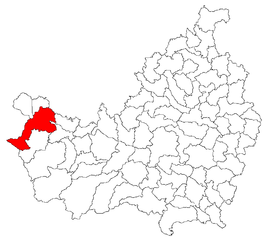Poieni, Cluj
Poieni (Hungarian: Kissebes; German: Klein Weichselburg) is a commune in Cluj County, Transylvania, Romania. It is composed of eight villages: Bologa (Sebesvár), Cerbești (Kecskéstanya), Hodișu (Hodosfalva), Lunca Vișagului (Viságmező), Morlaca (Marótlaka), Poieni, Tranișu (Tarányos) and Valea Drăganului (Nagysebes).
Poieni | |
|---|---|
 Location in Cluj County | |
 Poieni Location in Romania | |
| Coordinates: 46°55′11″N 22°51′55″E | |
| Country | |
| County | Cluj |
| Subdivisions | Bologa, Cerbești, Hodișu, Lunca Vișagului, Morlaca, Poieni, Tranișu, Valea Drăganului |
| Population (2011)[1] | 4,842 |
| Time zone | EET/EEST (UTC+2/+3) |
| Vehicle reg. | CJ |
Villages
Bologa
Bologa (Latin: Resculum; Hungarian: Sebesvár) is a village in the Poieni commune, with a population of 687 people (2002).
Geography
The village is situated at the confluence of the Crişul Repede and Henţ (Sebeş or Săcuieu) rivers (the confluence is known as "gura apelor" - "the mouth of the waters" - in the local toponymy) and at the foot of the Vlădeasa mountains (1863 m), part of the Apuseni Carpathians. The closest town is Huedin.
Transportation links: on the European route E60. Small railway stop ("haltă") for regional trains ("Personal") on the Oradea-Cluj-Napoca main Romanian railroad. On the national road 128 which heads South towards Săcuieu.
History
4000 years old artefacts (stone axes) were found at the place called "Drumul găunos" ("Potholed Road").
A Roman castrum called Resculum is the oldest documented settlement in the area. It was built around 106 AD, as a garrison for the “II Cohortis Hispanorum” (see Dux), whose mission was probably to defend the Roman Empire's border. As the Romans tried to tighten their hold on the region during the 2nd century A.D., they brought in colonists to the village from Greece, possibly from Patras.
The ruins of the castrum are still visible today in the place still called "Grădişte" which means "fortified settlement", although most of the area is cultivated. The ruins of a Roman bath also exist near the castrum.
Overlooking the castrum, on the opposite bank of the Henţ (Sebeş) river, on top of a steep hill lies one of the first Hungarian fortresses in Transylvania, which was mentioned for five centuries as Sebesvár, featuring on most Middle-Age maps of the region. Probably due to the fortress, the place was also known as Varalja ("under the fortress") or Sebesváralja. Bologa was first attested in 1304 as Sebuswar then as Sepuswar în 1324, Sebeswar -1329, Sebeswar alio nomine Hunyadwar - 1398, Castrum regis Sebes - 1393, Castrum regis Hunyad - 1397, Sebes Varallya - 1760.
The Hungarian king, Sigismund of Luxembourg after signing in Braşov an alliance treaty against the Turks in 1399 gave the fortresses of Bran and Bologa to Wallachia's prince Mircea cel Bătrân.
Built to watch the strategic road that went from Oradea inside Transylvania, the fortress also served as a refuge for the local population throughout the centuries. It gained in importance when the Turks conquered Oradea in the 17th century as it was hindering the tax collection. The sultan ordered its demolition but the order was not carried out. The fortress was later destroyed by the Austrian soldiers through explosion. The tower and many walls are still standing. In the mid 20th century the tower lost its roof, probably the last wooden element of the ruins. All that remains is stone.
Probably it was after the Romanian unification (1918) that the current name (Bologa) was assigned. The etymology is not clear.
The Second Vienna Award in 1940 temporarily re-situated Bologa in Hungary, right at the border (some territory on the hills nearby remained in Romania). This began yet another period of tensions between ethnic Romanians and Hungarians which ended in 1945 with the restoration of Romania's western border.
A stone quarry was opened in 1930 providing dacite stone for the Budapest-Bucharest road. The quarry was later on taken over by the Romanian railways, most of whose embankments are made of stone from the area. After 1989 the quarry was privatised and did not do very well comparing to neighbouring quarries, so it stopped being the main source of income for the villagers. The upcoming highway projects in Romania are expected to improve the quarry prospects.
Forestry is also active in the area, though more active in the neighbouring valley of Drăgan.
Agriculture is widely practiced but the land size and quality in the hilly-mountainous area only allows for the individual needs of the land owners.
The Potras
Most of today's village inhabitants (around 700) are ethnic Romanians, probably descendants of the original Roman population and its indigenous Dacian component. The language spoken is a variety of Romanian that includes Latin elements such as "ai" (from Latin alium, garlic) and "fărină" (from Latin farina, flour) which are not found outside the Carpathian basin, thus supporting the Romanian continuity theory.
The majority of inhabitants have the surname Potra, which according to accounts is a link to the colonists from Patras (the Potras/Patras variation exists in other Greek-related names too). Most of the Potras are said to have been shepherds, which probably allowed them not to become serfs to the dominant Hungarian nobility, thereby maintaining their relative prosperity and independence. The leading of the Potras were quite active in setting up the quarry as a cooperative, leading to even more prosperity. However, such entrepreneurship was not something that the communist regime could tolerate so a number of Potras were sent to forced labour.
Demographics
According to the census from 2011 there was a total population of 4,724 people living in this commune. Of this population, 93.96% are ethnic Romanians, 5.39% ethnic Romani and 0.6% are ethnic Hungarians.
References
- "Populaţia stabilă pe judeţe, municipii, oraşe şi localităti componenete la RPL_2011" (in Romanian). National Institute of Statistics. Retrieved 4 February 2014.
- Atlasul localităților județului Cluj (Cluj County Localities Atlas), Suncart Publishing House, Cluj-Poeni, ISBN 973-86430-0-7
External links
- "Transilvania" map by Ortelius, 1570. Bologa/Sebesuar is just above and to the right from the OCCIDENS indicator at the middle left of the map. This map is a color copy of the oldest known map of Transsylvania (Honter, 1532)
- The fortress and the stone quarry today
- The whirlpool at Bologa's watermill, a natural washing machine!
- The fortress of Bologa
- A description in Hungarian, featuring a coat of arms and early 20th century photography
- (in Romanian and Hungarian) Administrative map of the county
